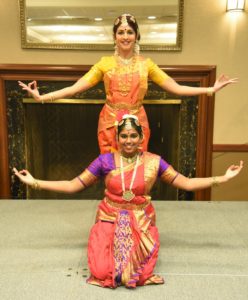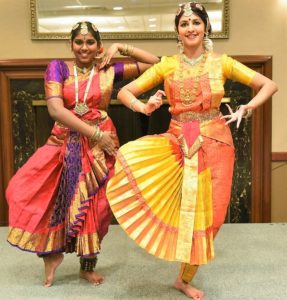2019 TRADITIONAL ARTS APPRENTICESHIP PROGRAM: SMRITA DORAIRAJAN AND CHARUNETHA MURUGESAN
We are excited to introduce you to master artist Smrita Dorairajan and her apprentice Charunetha Murugesan, first-time participants in Missouri’s Traditional Arts Apprenticeship Program.

Smrita Dorairajan and Charunetha Murugesan. Photo courtesy of Smrita Dorairajan
Since November 2018, Dorairajan and Murugesan, both of Columbia, have been meeting regularly at the master dancer’s studio for the apprentice’s lessons in Bharatanatyam. Perhaps the biggest cultural lesson that we may learn from this Indian traditional art form is that dance often involves so much more than simply how one moves one’s feet.
Like most traditional dancers we have met through TAAP, Smrita Dorairajan learned to dance as a child, and like most traditional dancers, Dorairajan points to a beloved family member who first introduced her to the tradition. She follows in the footsteps of her mother, learning first to dance as a young child and learning later to teach and sustain the tradition for a new generation. Dorairajan tells us that Bharatanatyam is essentially a vehicle for storytelling–older stories recount Indian mythology, for instance, while newer stories may address contemporary social issues, like cyberbullying. Thus, the stories are told in an intricate combination of dance steps, hand gestures, and facial expressions. The Bharatanatyam dancer adds context and emotion with a seemingly simple expression or gesture. In their lessons, Murugesan strives to move her skills and knowledge to the next level, working to refine her steps, improve her rhythm, and more confidently practice Navarasa–the nine emotions key to Bharatanatyam.

Bharathanatyam Gestures. Photo courtesy of Smrita Dorairajan
Each team that submits a TAAP application does so after reading the guidelines, and usually, after consulting with MFAP’s Folk Arts Specialist. The guidelines expressly state that apprentices should be experienced, not novices. Panelists who review applications look for evidence that apprentices demonstrate intermediate experience and strong commitment not only to learn during the apprenticeship but to continue into the future. Charunetha Murugesan noted in her application that she had achieved her arangetram in 2017, an event which we outsiders might liken to an upper level recital or type of graduation. She tells us that “Bharatanatyam for me has not only been my passion since childhood but an indispensable part of my life.” Now in high school, Murugesan continues to make time for her lessons, to practice her art form daily, to teach younger dancers in the studio, and to perform with Dorairajan’s Kalanjali School at cultural festivals and special events.
Recently, Dorairajan and Murugesan welcomed KBIA reporter Seth Bodine to observe one of their lessons, and he shared their story in an episode of the local NPR affiliate’s arts and culture segment Off the Clock. Follow the link here to listen to (or read) their story. https://www.kbia.org/post/traditional-arts-weave-cultural-fabric-missouri#stream/0
Later this week, the TAAP team will join master dancers, including Smrita’s mother Kalaimamani Padmini Dorairajan, as well as Kalanjali School students in performances at a special event in Columbia. MFAP staff looks forward to the opportunity not only to observe the TAAP team and its accomplishments, but also to behold as three “generations” practice their traditional arts. The event is open to all and will take place on June 1, 2019 from 5:30-7:30 p.m. at Rockbridge High School Auditorium, 4304 South Providence Road in Columbia.
The heart of Missouri Folk Arts Program is its Traditional Arts Apprenticeship Program. Master artists work one-on-one with apprentices to keep folk arts knowledge and practices alive. In Missouri, with support from the National Endowment for the Arts, the Missouri Arts Council, and the University of Missouri, the first master-apprentice lesson took place on December 10, 1984. Since then, Missouri has supported over 400 apprenticeships in which 200+ master artists have mentored more than 500 apprentices in every region and many communities in the state. Many apprentices have in their turn grown in their artistry and later recognized as master artists in TAAP. They forge anew living links in the chain of Missouri’s folk arts. Some TAAP artists practice traditional regional crafts that date back to Missouri’s Native American peoples and early European settlers. Some newer immigrants, such as Latinxs, Sudanese, and Bosnians, have sustained their artistic traditions in their new homes in Missouri. Still more traditions have migrated to Missouri from other regions of the U.S. All are re-imagined and honed into dynamic Show Me State traditions. Among the arts that have been fostered in TAAP over the decades are blacksmithing, cowboy poetry, old-time short-bow fiddling, African-American storytelling, Ozark Riverways paddle carving, Vietnamese dragon dancing, Western saddle making, old-time clawhammer banjo, wood joinery, square dance calling, German bobbin lace, turkey calls, Mexican paper flowers, and Slovenian button-box accordion.
[Posted May 29, 2019 by Lisa L. Higgins]
